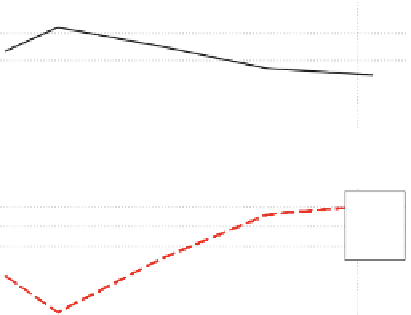Biomedical Engineering Reference
In-Depth Information
a
2.85
E
e
E
e
E
e
2.8
2.75
2.7
2.65
2
4
6
8
D
(nm)
b
E
1
h
E
2
h
E
3
h
0.56
0.54
0.52
0.5
0.48
0.46
2
4
6
8
D
(nm)
Fig. 6.9
The same as in Fig.
6.7
but this time for the first three bound (
a
) electron and (
b
) hole
states when taking strain and built-in field into account. [From [
91
]]
biaxial compressive strain, with a much smaller biaxial strain at the top of the dot.
The barrier material above the QD experiences a biaxial strain of opposite sign to
that at the dot base. Therefore, we deduce by applying linear elasticity theory that for
closely spaced QDs, the bottom of the upper dot should experience a reduced biaxial
strain compared to the bottom of the lower dot. Because these biaxial compressively
strained regions are more favorable for (heavy-) hole states, one could expect that the
hole states are localized at the bottom of the lower QD. This is exactly the situation
we find here for the first few bound hole states.
6.6.1.3
Influence of Built-In Potentials on the Electronic Structure
Having analyzed the impact of the strain field in the previous subsection, we
include now also the total built-in polarization potential
φ
tot
in the description of
the electronic structure of the In
0
.
25
Ga
0
.
75
N/GaN QDMs.
Figure
6.9
a shows, as a function of
D
, the single-particle energies
E
1
,
2
,
3
for the
e
1
,
e
2
e
3
while (b) depicts the energies
E
1
,
2
,
3
first three bound electron states
ψ
ψ
and
ψ
h
h
2
h
for the first three bound hole states,
3
. As expected from the QCSE, the
electron states are shifted to lower energies while the hole states are shifted to higher
energies, compared to the situation without the built-in field (cf. Fig.
6.8
). Moreover,
when looking at Fig.
6.9
, we find that the molecular-like description of the single-
particle states now breaks down for both electrons and holes. Additionally, an
interesting feature is observed in the energy spectrum for electrons and holes around
D
ψ
1
,
ψ
and
ψ
φ
tot
breaks the
symmetry between the two QDs, as discussed in Sect.
6.5
, one might expect that
≈
2 nm, where we observe a kink in the spectrum. Even when



















































































